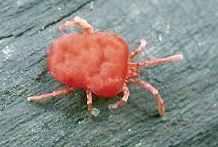ManageSafe™
Least-Toxic Control of Chiggers Choose a different pests

|
Factsheet: Least-toxic Control of Chiggers
Identification
Pest type: Insects
Chiggers are bright red mites about 1 mm in length. During their larval stage, they are parasitic to vertebrates including humans. Chiggers commonly inhabit thickly vegetated and damp, shady areas such as in tall grass, along forest edges, and in wild blackberry patches. They can also live on lawns and golf courses. Chiggers wait in these areas and transfer to a host as it brushes by them. On humans, this is usually in areas where clothing is tight: the waist, crotch, armpits and ankles.
Is it a problem?
Chiggers are pesky, itchy, and uncomfortable pest. After transferring to a host, a chigger will insert digestive juices into skin cells and ingest the cell contents. Skin will start itching about three to six hours after being bitten. Chiggers do not suck blood, and do not burrow into the skin. After a few days, they will simply drop off their host.
Pest prevention practices
Dispose of trash
Remove potential habitat
Remove clutter
Foster natural resilience
When entering an area that may be inhabited with chiggers, close off all openings in clothing. Tuck socks into pants, wear rubber bands on sleeves around the wrists, and wear zippered clothing rather than buttons.
Keep vegetation in check by pruning back overgrowth.
Decreasing overall moisture will make the area less attractive to chiggers.
Continue these practices year after year as chiggers burrow into soil during the winter months and may re-infest an area in the spring.
Monitoring and record-keeping
Place six-inch squares of black cardboard on edge in the grass and observe for a few minutes. Any small, yellowish or pinkish chiggers present will climb rapidly to the top of the square and congregate there. Make tests in 10 to 12 different spots such as grass, dead leaves, briars, weeds, to determine infestation levels.
Non-chemical and mechanical controls
Remove trash from property
Remove clutter
Remove debris and habitat
After being in a susceptible area, shower with warm soapy water, and scrub possibly infested skin. If you can’t shower right away, rub your skin down with a towel.
Afterwards, carefully examine skin with a magnifying lens to make sure all chiggers have been removed. Wash all clothing and blankets in water 125 degrees or above.
Biological controls
Biological controls are not effective for chigger management.
Least-toxic chemical options as a last resort
Direct, chemical control of chiggers is usually impractical. Large areas would have to be sprayed several times for effective control.
Chemicals to Avoid
Look at your product labels and try to avoid products containing those chemicals listed below:
(A = acute health effects, C = chronic health effects, SW = surface water contaminant, GW = ground water contaminant, W = wildlife poison, B = bee poison, LT = long-range transport)
|
Bifenthrin Carbaryl Cyfluthrin | Cypermethrin DEET Deltamethrin | Esfenvalerate Lambda-cyhalothrin Permethrin | Pyrethrins Tetramethrin Tralomethrin |
Social Media
See what other folks are saying about this, and let us know what works for you.
Click the post above to view and comment on Facebook, or comment directly on this site below.








